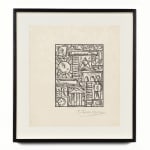Joaquín Torres-García
Further images
Amidst the fervent artistic evolution of Paris in the late 1920s and 1930s, Uruguayan-born artist Joaquín Torres-García positioned himself as a visionary architect of abstraction. In Paris, his work took a new direction that resonates through the annals of modernism. As a founding member of the group 'Cercle et Carré,' which galvanized artists who shared a passion for the abstract and the geometric, Torres-García championed a form of expression that brought together the ancient world and the avant-garde.
The early 1930s are an inflection point in Torres-Garcia’s oeuvre, a moment where his artistic language crystallized in a new orthodoxy defined by the architectonic harmony of form. The artist distilled his vision into the profound narrative of 'Universalismo Constructivo.’ This manifesto not only declared his principles but offered a blueprint for the integration of abstract art with universal symbolism. The present woodcut completed in 1934, crafted on the tactile expanse of Japan paper, is a testament to Torres-García's conviction that art could articulate a fundamental, near spiritual language. The medium of the woodcut, with its deep roots in preindustrial craftsmanship, was the chosen medium for this dialogue, linking the ancestral past with the modernist future.
The structural integrity of this remarkable work in printmaking mirrors the constructive reliefs that Torres-García was producing at this time, both mediums allowing him to explore the intrinsic properties of wood—its grain, its resistance, its capacity to bear the weight of ink and intent. In this woodcut, one can discern the very fibers of the wood through the density of the ink, a tactile geography that maps out the artist's journey through abstraction. Each impression is a document of his process, an indelible record of a moment in time when Torres-García aligned the corporeal with the conceptual.
Published within the portfolio ‘23 Gravures’ curated by art critic and collector Anatole Jakovski, this woodcut was accompanied by works by other leading artists working in Paris in the 1930s including Pablo Picasso, Joan Miró, Alexander Calder, and Wassily Kandinsky among others. Jakovski's curatorial acumen collected a compendium of innovation, enshrining the narrative of an artistic epoch. With this work on paper, Torres-García's iconography—geometric forms, archetypal symbols, and cosmic motifs—articulates a dialect of abstraction that is at once arcane and absolute. Other proofs of this important woodcut are housed in the esteemed collections of The Museum of Modern Art in New York and The Brooklyn Museum, NY.
Provenance
Private collection, EuropePrivate collection, United States
Private collection, New York
Literature
Cercle et Carré (Círculo y cuadrado). Revista de la Asociación de Arte Constructivo, No. 3, Montevideo, Uruguay, 1937, illustrated on the cover.






